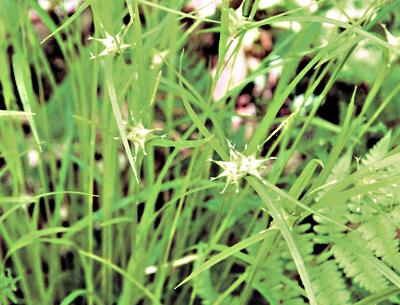Nature Notes: Sedge Heaven

The Sunday Newsday crossword puzzle requested a five-letter word for “swamp plant.” I’ve been doing all of the Newsday and New York Times crosswords, seven days a week, since the early 1980s. In other words, I’ve done thousands of crosswords and saved them all. Whether a given puzzle over the years has requested a substitute for swamp plant, marsh plant, or bog plant, the only three answers I’ve encountered are two four-letter words, “rush” and “reed,” and the five-letter one asked for on Sunday, “sedge.” There are many other wetland plant types, but for obvious reasons these are the three that the solver fills in the squares with over and over again.
Sunday’s “sedge” answer was particularly apropos as I had just come back on Thursday from a three-day sedge workshop at Morrisville State College in western New York hosted by the New York Flora Association. I went with two fellow enthusiasts, Karen Blumer and Victoria Bustamante. Those two stayed with the sedge master and the other 15 or so participants through thick and thin, wet and dry. I lasted until Thursday morning — sedges coming out of each ear and clogging my brain — but had to throw in the towel early.
Why sedges? Well, sedges may be the most nondescript and the most numerous wetland group in the world. At the moment there are more than 2,000 sedge species worldwide, all in the genus Carex. Several new ones are described by botanists each year, and there are still many more to discover. Not counting the varieties, there are some 218 different sedges in New York State, less than 10 of which are considered aliens. What makes individual sedges the most difficult of the higher plants to identify is the fact that to almost everybody, including most botanists, they all look alike. To the layperson, they are easily confused with rushes and grasses. Only the very brave or very peculiar botanist dares take them on.
They differ from rushes and grasses and almost all other higher plant groups in one very important respect — they lack sepals and petals. The female seed is housed in a tiny saclike structure called a perigynium seated at the base of a covering scale, several female flowers make up a spike. The male flowers occur on the same stem, often in a separate inflorescence, but in a few species the male and female flowers are dioecious, they occur on separate plants, as in hollies, sassafras, and many other flowering plants.
Like pines, cottonwoods, willow, oaks and many other tree species, sedges are almost invariably wind-pollinated, thus it helps to have both female and male flowers close to each other.
The South Fork is species-rich in sedges — more occur here than perhaps any other part of Long Island — and has some of the rarest in New York State such as the state-threatened seorse sedge, Emmon’s sedge, and lupuliniform sedge. Montauk, with its plethora of wetlands of many different kinds, is the sedgiest place on Long Island and maybe even in the state or country. Ironically, our most common sedge on Long Island is a dry-land sedge, Carex pensylvanica, Pennsylvania sedge. It’s that low, grassy-looking stuff you see in oak woods, say along Hand’s Creek Road in Northwest. It becomes the common ground cover during gypsy moth caterpillar infestations. The light falls on its leaves in buckets in the absence of oak leaves.
Although there are several upland sedges, some that grow in dry woods, others in dry fields, sedges are the most common wetland species. The wetland ones are almost all confined to freshwater wetlands, but a few grow at the upper edges of salt marshes such as around Lake Montauk.
The word sedge derives from the Old English word, “sagu,” for saw. Many sedges have leaves and stems with fine saw-tooth edges. Some can give you a nasty cut if you rub against them with bare legs. Ticks are also fond of questing on the stems and leaves of some upland sedges, as they do on upland grasses. Many sedges have stem cross-sections that are triangular in outline. A few sedges have stems, or culms, that are succulent at their bases, as are several grasses, and can be chewed and sucked on.
I lugged a big book up to the workshop that had all of the North American sedges in it with illustrations of many of them. Our sedge meister was Antonio Reznisek from the University of Michigan. He knew just about every sedge in the world. While he was helping ID some of the ones we collected, I opened the book to the Carex section. Guess what? The sedge section was co-authored by none other than the same Mr. Reznisek. A coincidence, don’t you think?
But I was happy to get home. My brain was filled with this and that Carex name and had stopped working altogether. It cleared by Sunday, just in time to correctly answer the five-letter word for swamp plant in the Newsday crossword, S E D G E.
